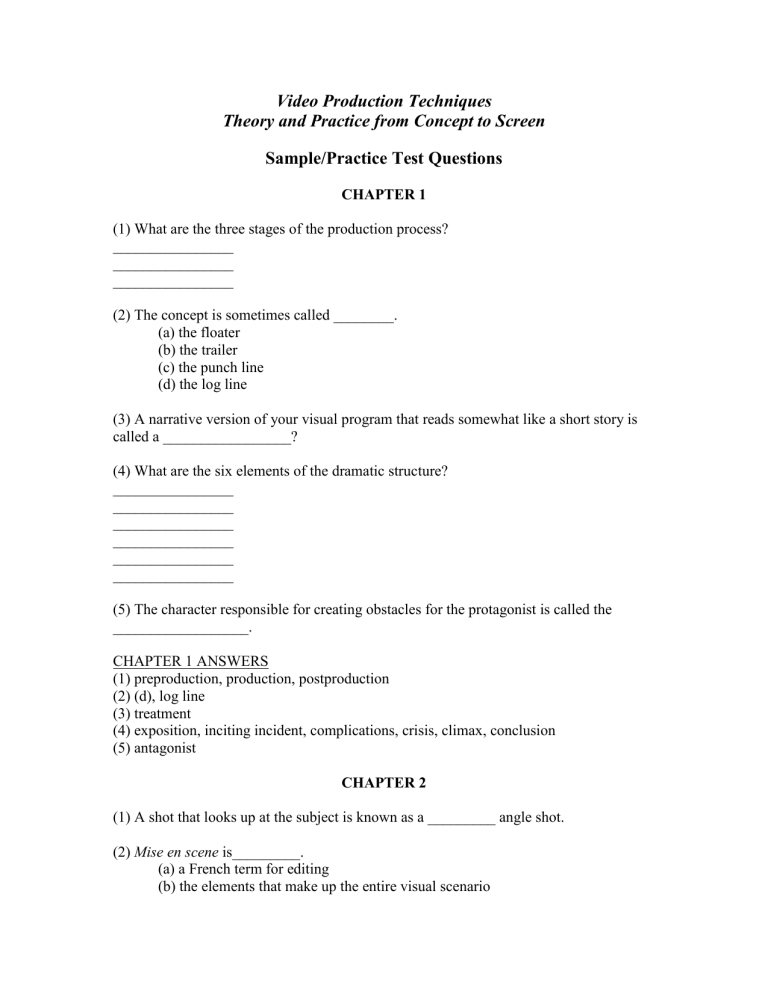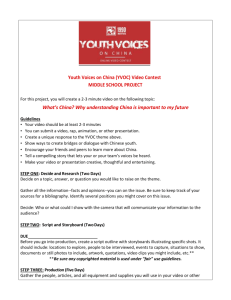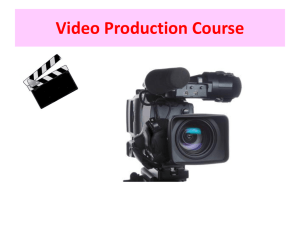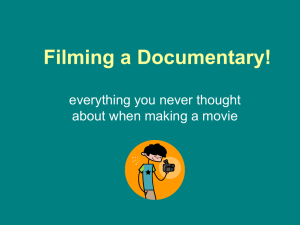Test Bank - Routledge

Video Production Techniques
Theory and Practice from Concept to Screen
Sample/Practice Test Questions
CHAPTER 1
(1) What are the three stages of the production process?
________________
________________
________________
(2) The concept is sometimes called ________.
(a) the floater
(b) the trailer
(c) the punch line
(d) the log line
(3) A narrative version of your visual program that reads somewhat like a short story is called a _________________?
(4) What are the six elements of the dramatic structure?
________________
________________
________________
________________
________________
________________
(5) The character responsible for creating obstacles for the protagonist is called the
__________________.
CHAPTER 1 ANSWERS
(1) preproduction, production, postproduction
(2) (d), log line
(3) treatment
(4) exposition, inciting incident, complications, crisis, climax, conclusion
(5) antagonist
CHAPTER 2
(1) A shot that looks up at the subject is known as a _________ angle shot.
(2) Mise en scene is_________.
(a) a French term for editing
(b) the elements that make up the entire visual scenario
(c) the perspective that creates a vanishing point
(d) related to the aspect ratio
(3) A _______ angle shot is achieved by setting the camera position above the subject.
(4) If you have “crossed the line,” what rule have you broken?
(a) Rule of montage
(b) Temporal continuity
(c) 180-degree rule
(d) Leadroom rule
(5) A ________ shot captures the entire range of action in the scene from start to finish from one camera angle.
(6) According to the rule of thirds what is the most the interesting way to frame a composition?
(a) A balanced symmetrical frame
(b) A focus on the center of the frame
(c) Asymmetrical framing
(d) A close-up
(7) A _______ shot is always subjective.
(8) Pivoting the camera from side to side on a fixed point is known as a ________.
(9) A transition in which one image fades out while another one fades in is called a
_______.
(10) In writing we often think in terms of units such as letter, word, sentence, paragraph and document. In video we often think in terms of …. (fill in missing terms) a. Frame b. ___________ c. ___________ d. ___________ e. Feature or Episode
(11) What is the aspect ratio of standard television? ____________
(12) What is the aspect ratio of HDTV? ____________
(13) What does each of these initials stand for?
L.S. ________
M.S. _______
C.U. _______
E.C.U. ________
CHAPTER 2 ANSWERS
(1) low-
(2), the elements that make up the entire visual scenario
(3) high-
(4) (c), 180-degree rule
(5) master
(6) Asymmetrical framing
(7) point-of-view
(8) pan
(9) dissolve (a.k.a. lap dissolve, overlap dissolve, cross-fade)
(10) shot, scene, act
(11) 4:3
(12) 16:9
(13) long shot, medium shot, close-up, extreme close-up
CHAPTER 3
(1) A lens with a single glass element whose magnification cannot be changed is called a
__________.
(a) compound lens
(b) zoom lens
(c) prime lens
(d) wide-angle lens
(2) The ________ setting controls how much light passes through the lens to the imaging surface of the camera.
(a) aperture
(b) tripod
(c) zoom
(d) image stabilizer
(3) An f-stop setting of f/4 lets in more or less light than f/2? ____________
(4) Depth of field can be adjusted by
(a) manipulating the amount of light that enters the lens
(b) zoom level
(c) focal point
(d) all of the above
(5) _______ filmmaking typically utilizes practical, available light sources.
(a) Impressionistic
(b) Realistic
(c) Expressionistic
(d) Surrealistic
(6) The ________ gathers additional footage that does not require the main actors or the full crew.
(a) clapper/loader
(b) dolly grip
(c) second unit
(d) boom operator
(7) A _________ allows the smooth movement of a camera across the floor.
(8) In a video camera, the ________ control allows you to electronically boost the sensitivity of the imaging system to capture images in low light situations.
(a) white balance
(b) image stabilizer
(c) tally light
(d) gain
(9) The _________ is an adjustable three-legged piece of equipment that provides stability for the camera while shooting.
(10) How many lines of horizontal resolution are standard in NTSC? ________
(11) How many frames per second are standard theatrical films in the United States?
_________
(12) What is the frame rate per second of standard video/television in the U.S.? ______
(13) Complete the f-stop scale below…
1; _____; _____; _____; _____; _____; _____; _____; _____; 22
(14) Will each of the following create more or less depth of field?
Small Aperture _________
Close Focal Point _________
Long Focal Length Lens ________
(15) Is a prime lens a fixed focal length lens? _________
(16) Chapter 3 introduces some approaches in cinematography and videography.
Concrete irrationality and dream imagery are hallmarks of what approach discussed in the
Chapter? __________________
CHAPTER 3 ANSWERS
(1) (c), prime lens
(2) (a), aperture
(3) less
(4) (d), all of the above
(5) (b), Realistic
(6) (c), second unit
(7) dolly
(8) (d), gain
(9) tripod
(10) 525
(11) 24
(12) 30
(13) 1,4. 2, 2.8, 4, 5.6, 8, 11, 16
(14) more, less, less
(15) yes
(16) surrealism
CHAPTER 4
(1) Analytic editing in which you start with a wide view and then move in closer to reveal detail is called __________.
(a) inductive scene construction
(b) dramatic editing
(c) deductive scene construction
(d) parallel construction
(2) The editor is responsible for _________, which involves making sure that the program makes sense within the rules of its aesthetic and its approach.
(a) holistic continuity
(b) real time
(c) montage
(d) linear media
(3) _______ can motivate a cut from one shot to another.
(a) Action
(b) Dialogue
(c) Pace
(d) All of the above
(4) ________ is the term utilized to denote a collection of images edited together with the intent of a compression of, or an elaboration of, events.
(a) Lyrical editing
(b) Montage
(c) Metric editing
(d) Linear editing
(5) Cutting on the action is one way to justify a cutting point. List two other ways to cut around action. ___________ _____________
(6) ________ editing is when you are making creative decisions with low resolution footage, or editing in the draft mode.
(a) Off-line
(b) On-line
(c) By-line
(d) Parallel
(7) A ________ is a record with key information about every shot including time code, content of the shot and quality of the shot.
(a) time code indicator
(b) tally sheet
(c) camera log
(d) shot list
(8) What is a shooting ratio?
(9) Eisenstein felt that film editing is a…
(a) marriage
(b) linkage
(c) collision
(d) cokob (“union”)
(10) To obtain legal copyright protection you must register with the U.S. Copyright
Office.
(a) True
(b) False
CHAPTER 4 ANSWERS
(1) (c), deductive scene construction
(2) (a) holistic continuity
(3) (d) All of the above
(4) (b) Montage
(5) Leading the action, Following the action
(6) Off-line
(7) camera log
(8) The ratio footage shot to footage used in the final program
(9) collision
(10) false
CHAPTER 5
(1) The strategic purchase of airtime for commercials is a ________.
(a) underrater cosign
(b) media buy
(c) bottom line purchase
(d) Neilsen inventory
(2) One of the most important questions to ask in advertising research is, “_______.”
(a) How much money am I getting paid?
(b) What advertising appeal should I use?
(c) What is my target audience?
(d) Who is my spokesperson?
(3) There are four main types of advertising appeals including reason and fear. List the other two. __________ ____________
(4) The advertising style determines how the message is communicated and organized.
Some styles include montage, symbolism & testimonials. List 3 others.
_________
_________
_________
(5) A ________ is a collection of individuals from the community who are paid to come in and talk about their reactions to your commercial.
(a) focus group
(b) creative group
(c) audience survey group
(d) presentation group
(6) What is a PSA? ____________________
(7) When a company selects an advertising agency through a formal bidding process they sometimes put out a call for RFPs. That does “RFP” stand for? __________________
(8) Television commercials often use a ____________.
(a) top-down script
(b) over-under script
(c) bifurcated treatment
(d) split-page script
CHAPTER 5 ANSWERS
(1) (b), media buy
(2) (c), What is my target audience?
(3) Emotion, Humor
(4) Spokesperson, Musical formats, Narratives
(5) (b), focus group
(6) Public service announcement
(7) Request for proposal
(8) split-page script
CHAPTER 6
(1) Controlling light in a visual production is achieved through balancing four major lighting elements including the amount of light and the quality of light. List the other 2 elements. ________________ _________________
(2) List the 3 lights used in three-point lighting.
______________
______________
______________
(3) What is the additional light in four-point lighting called? ______________
(4) Making an electronic adjustment for overall color correction with your video camera is known as____________.
(a) color temperature
(b) additive color
(c) white balancing
(d) subtractive color
(5) Filters can be used ___________.
(a) over the light source
(b) over the camera lens
(c) in postproduction
(d) all of the above
(6) Video uses light. Does light function by additive or subtractive color? ____________
(7) What are the three primary colors of light used in video recording and projection/playback?
______________
______________
______________
(8) Identify two ways that you can color correct lighting (daylight and tungsten) in a mixed lighting situation.
_______________________________________________
_______________________________________________
(9) What are the color temperatures (in degrees Kelvin) of average daylight at noon
_______ and tungsten light _________?
(10) If you have a scene that is predominantly lit with a key light, resulting in high contrast, and dark sinister shadows, this an example of high-key or low-key lighting?
________________
(11) What is the name of the flaps on the outside of a lighting instrument that can be adjusted to control light spill and to block light from hitting certain parts of the set?
________________
CHAPTER 6 ANSWERS
(1) Color, Direction
(2) Key light, Fill light, Back light
(3) Background light
(4) (c), white balancing
(5) (d), all of the above
(6) Additive
(7) Red, Green, Blue
(8) Put orange gels on the windows, put blue gels on the tungsten lights, or use HMI light, which are balanced for daylight
(9) Approximately 5,500 degrees Kelvin (daylight at noon) and 3,200 degrees Kelvin
(tungsten)
(10) Low key
(11) Barn doors
CHAPTER 7
(1) ________ microphones function with a moving coil. They are rugged and good for outdoor use.
(a) Capacitor
(b) Dynamic
(c) Cardioid
(d) Omnidirectional
(2) There are 3 ways basic characteristics that are used to classify microphones including the pick-up element. List the other 2 ways. ______________ _________________
(3) ________ refers to sounds that are not recorded in sync with the picture.
(a) Wild track
(b) Reference tone
(c) Capacitor sound
(d) Hard effects
(4) The ______ microphone is small and effective for recording interviews or dialogue pieces. It can be affixed to a collar or underneath clothes.
(a) boundary
(b) parabolic
(c) lavaliere
(d) shotgun
(5) A ______ is a support pole used to hold a microphone out of view of the camera.
(a) headroom pole
(b) on-axis pole
(c) off-axis pole
(d) boom pole
(6) ________ recording is the process of creating sound effects in a studio to match visuals on the screen.
(a) ADR
(b) Foley
(c) Room tone
(d) Parametric
(7) This person crafts audio in postproduction and guides the audience by layering location sound, rerecorded dialogue, music, and sound effects.
(a) sound effects editor
(b) sound designer
(c) audio engineer
(d) composer
(8) Which type of microphone needs some sort of power source, such as batteries or phantom power?
(a) Dynamic microphone
(b) Capacitor microphone
(9)The measurement of pitch in audio is referred to as _________.
(a) amplitude (Db)
(b) frequency (Hz)
(10) The process of actors and actresses re-recording their lines in postproduction is called ___________.
(a) narration
(b) ADR
(c) sound sweetening
(d) Foley
CHAPTER 7 ANSWERS
(1) (b), dynamic
(2) Directionality and frequency response
(3) (a), Wild track
(4) (c), Lavaliere
(5) (d), boom pole
(6) (b), Foley
(7) (b), sound designer
(8) (b), Capacitor
(9) (b) frequency
(10) (b), ADR
CHAPTER 8
(1) Name or describe the first film to be widely called a "documentary." ____________
(2) Which nonfiction approach acknowledges that the camera, the filmmaker, and the question can alter the event to create a deeper reality? ____________
(3) Which nonfiction approach includes editing footage chronologically? ____________
(4) Picture that is inserted over the top of interviews to exemplify what the person is saying is called ____________.
(5) ___________, or corporate film, is produced for a business or other organization to serve a communication objective.
(6) News stories that are shot in the field and edited together are called ____________.
(a) historical documentaries
(b) NATSOT
(c) packages
(d) sound bites
(7) The ___________ oversees the entire news production and is responsible for making sure that everything runs on schedule.
(a) director
(b) producer
(c) floor manager
(d) technical director
(8) A treatment is the sales tool in fiction film, while a ________ is the sales tool for documentaries.
(a) grant
(b) proposal
(c) outline
(d) script
(9) Once a news story is assigned, scripting a news segment begins with selecting
__________.
(a) an angle
(b) the location
(c) b-roll
(d) a director
(10) A valuable way to make sure that you ask the right questions on camera is to conduct a _________ with the person you are planning to interview.
CHAPTER 8 ANSWERS
(1) Nanook of the North
(2) Cinema Verite
(3) Direct cinema
(4) B-roll
(5) Industrial
(6) (c), packages
(7) (b), producer
(8) (b), proposal
(9) (a) an angle
(10) preinterview
CHAPTER 9
(1) What does EXT. indicate in a screenplay? ____________
(2) Character names located above segments of dialog are centered on the page in a screenplay?
(a) True
(b) False
(3) What is a completion guarantee?
(a) A contract with the actors
(b) An agreement for equipment rental
(c) A distribution deal
(d) An insurance policy
(4) What is spotting?
(a) looking for errors on the raw footage to select usable takes
(b) deciding where sound effects and music will go
(c) deciding how actors will move and how equipment will be placed
(d) making sure a stunt double does not get injured
(5) The production schedule is created by the _______________.
(a) line producer
(b) script supervisor
(c) unit production manager
(d) executive producer
(6) Films are generally constructed in ______________.
(a) one act
(b) two acts
(c) three acts
(d) four parts
(7) The __________ is a sample episode used to demonstrate the program concept & approach to potential buyers.
(a) series
(b) syndication
(c) pilot
(d) episode
(8) _________ is a dramatic moment in the story that points the story in a new direction.
(a) An epilogue
(b) A prologue
(c) A teaser
(d) A plot point
(9) A translation of the script into a list of props, actors, locations and number of production days is called _____________.
(a) a script breakdown
(b) below the line expenses
(c) above the line expenses
(d) daily production report
(10) This person is in charge of continuity on the set.
(a) Script supervisor
(b) Assistant director
(c) Line producer
(d) 1st assistant camera
(11) __________-the-line are expenses that are generally variable such as salaries and benefits of the director and principals; whereas _______-the-line expenses are fixed such as camera rental, etc.
CHAPTER 9 ANSWERS
(1) Exterior
(2) False
(3) (d), Insurance Policy
(4) (b), Deciding where sound effects and music will go
(5) (c), unit production manager
(6) (c), three acts
(7) (c), pilot
(8) (d), A plot point
(9) (a), a script breakdown
(10) (a), Script supervisor
(11) Above, below
CHAPTER 10
(1) The director is accountable to ________.
(a) the producer and financiers
(b) the crew
(c) the cast
(d) all of the above
(2) When you are having a hard time evoking a performance from an actor it is a good idea to read the line to them so that they can hear how you want it performed.
(a) True
(b) False
(3) Directors who are also screenwriters and have a body of work which portray a unity of vision, style and sometimes theme are referred to as _________.
(a) uber-directors
(b) auteurs
(c) method directors
(d) producing directors
(4) The process of planning the placement and movement of the actors and camera is called ____________.
(a) screen testing
(b) blocking
(c) striking
(d) creating the rushes
(5) The first step in the rehearsal process is often a ________.
(a) screen test
(b) technical rehearsal
(c) table read
(d) casting call
(6) Directing is coordination, _________________ and ______________________.
(7) Filmmaking is a democratic process.
(a) True
(b) False
(8) Effective directing is _________.
(a) process oriented
(b) result oriented
CHAPTER 10 ANSWERS
(1) (a), the producer and financiers
(2) (b), False
(3) (b), auteurs
(4) (b), blocking
(5) (c), table read
(6) interpretation, evoking performance
(7) (b), False
(8) (a), process oriented
CHAPTER 11
(1) __________________ is the process of informing an audience about the existence of a program.
(2) __________________ is the mechanism of actually making the content of the program available to the audience.
(3) In ______ a distributor teams up with another type of business, which shares the same target audience.
(a) a marketing campaign
(b) a cross-promotion
(c) an electronic press kit
(d) a press junket
(4) As an independent producer the most realistic option(s) for distribution is/are
____________.
(a) approaching a niche cable network
(b) contracting with a professional distributor
(c) Internet distribution
(d) all of the above
(5) What is a one sheet? ___________________
(6) What is an EPK? ______________________
(7) _________ is an expanding horizon of program delivery
(a) Theatrical play
(b) Second-run release
(c) Cellular phones
(d) SMK
(8) VHS tapes are superior to DVDs due to their low cost, linear design, and more surface area for eye-catching box art
(a) True
(b) False
CHAPTER 11 ANSWERS
(1) Marketing
(2) Distribution
(3) cross-promotion
(4) (d), all of the above
(5) A movie promotional poster
(6) Electronic press kit
(7) (c), Cellular phones
(8) (b), False
CHAPTER 12
(1) One of the best ways to angle into an entry-level position in video production is through _______________.
(a) classified advertisements
(b) cold-calling
(c) sole-proprietorship
(d) an internship
(2) Most jobs in production are obtained though ___________.
(a) professional journals
(b) online postings
(c) networking
(d) placement services
(3) Your __________ is your most important tool in job hunting and client recruitment.
(a) show reel
(b) academic Web page
(c) one sheet
(d) production report
(4) Film festival participation is a good avenue for gaining professional feedback and for developing collaborations.
(a) True
(b) False
(5) A business entity that is distinct from its founders and shareholders is a
(a) sole proprietorship
(b) limited liability company (LLC)
(c) corporation
(d) limited liability partnership (LLP)
CHAPTER 12 ANSWERS
(1) (d), an internship
(2) (c), networking
(3) (a), show reel
(4) (a), True
(5) (c), corporation







